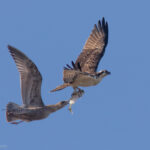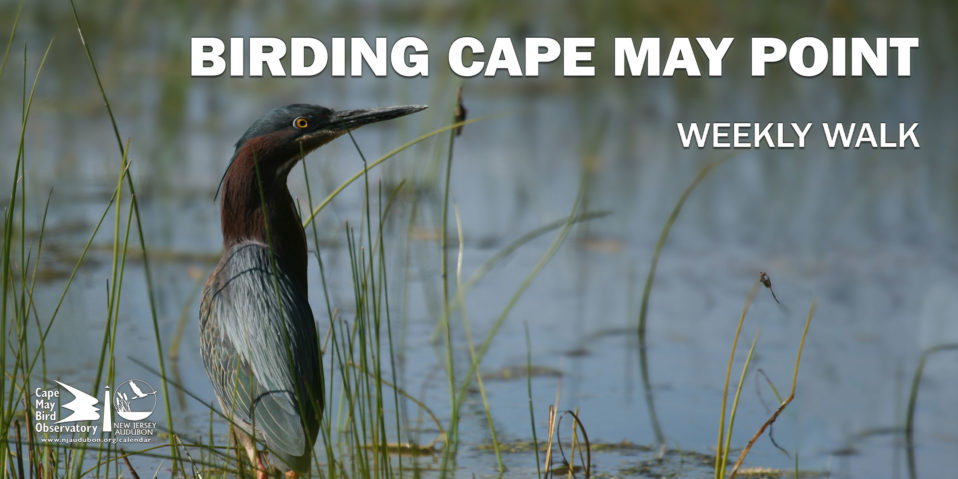Introduction
Spring greetings from Cape May! The 2020 Cape May Springwatch season took flight on Sunday, March 1, and daily migration monitoring will continue at Cape May Point through the last day of May.
We are extremely grateful to collaborators Larry & Judy Winne, whose support again makes the work we do possible. CMBO is also appreciative of continued partnerships with data entry provider Trektellen, which offers unparalleled solutions for migration count projects, and the Borough of Cape May Point, which allows us access to the count site at Coral Avenue. I will again coordinate field operations this season with assistance from Jason Bojczyk, this year’s Springwatch Technician. Jason arrives at Cape May with a wealth of experience from migration counts across the country, and we are excited to have his help.
Folks who are familiar with the Springwatch program will notice some additions in 2020, namely in the form of surveys aimed at tabulating grounded migrants. A morning census route at Cape May Point State Park will be supplemented by a survey of the South Cape May Meadows during the PM hours. We will use the data gleaned from these exploratory, additional efforts to compare with the totals accrued from the visible migration count at Coral Avenue, resulting in a more comprehensive and well-rounded picture of how spring migration unfolds here at land’s end.
Weather Summary
The season’s opening day was met with strong northwest winds behind a departing cold front. Wind chills in the 20s are not exceptional by early March standards, but given the overall mild weather of late, the chill felt far worse than usual! Temperatures quickly rebounded and moderated through the workweek, with ample sun and sustained southerly/westerly winds bringing a decidedly spring-like feel to the afternoons. The sunshine eventually gave way to thickening cloud cover and a low pressure system that dropped about an inch of rain on Friday, followed by another sweeping cold front that left us with strong northerlies and a brief cooldown to end the period.
Migration Summary
A strong gull movement on northwest winds March 1 included 319 Bonaparte’s Gulls and 107 Ring-billed Gulls. This was followed by a swift warm-up and a shift to south winds on the evening of March 1, triggering a goose movement that brought 1,398 Canada Geese past Coral Ave the next morning; the season’s first American Oystercatchers (4) were also recorded. Sustained southerly flow allowed for more migration March 3, when the season’s first Pine Warblers (3) and Piping Plover were detected. Decent waterfowl diversity was noted on March 4, along with the season’s first Tree Swallows (5+) and a mildly unexpected Red-breasted Nuthatch. Northerly and then easterly winds started to slow migration March 5-6, though the first 3,000+ Northern Gannet day was notched at Coral Ave and multiples of Greater and Lesser yellowlegs appeared at the South Cape May Meadows. Another noticeable gull movement (again on northwest winds) rounded out the week March 7, along with a strong push of 6,000+

Northern Gannets. The morning census at Cape May Pt. State Park turned up 41-45 species each day and 65 species across the entire period; census highlights are included below.

March 8-14 Outlook
A peek at the upcoming week’s forecast shows some promise for a steady influx of northbound migrants, with temperatures generally near or above average and little precipitation expected. Southwest winds are expected from Sunday afternoon through Tuesday evening, a nice stretch of favorable conditions for the first half of March. Potential arrivals we’ll be on the lookout for include Snowy Egret, Glossy Ibis, Osprey, and Purple Martin, with other less likely possibilities on our radar if it gets mild enough!
Notable Species
The following rare, unseasonable, or otherwise noteworthy species were reported within the Springwatch recording area during the past week:
Blue-winged Teal: three individuals that successfully spent the winter at Cape May Pt. State Park were joined by a newly-arrived migrant on March 5.
Common Merganser: this species is always scarce at Cape May Point, especially on the heels of a mild winter. One female type continued on Lily Lake and the Cape May Pt. State Park ponds through March 7, and another flew east past Coral Ave with Red-breasted Mergansers on March 6.
Ruby-throated Hummingbird: the wintering, hatch-year female continues to frequent at least a couple of Cape May Point backyards; it has also been seen flycatching on warmer days. This hardy individual potentially represents the first March record for the species in Cape May County and is presumably in line to become the first to successfully overwinter.
Black-legged Kittiwake: a first-cycle individual flew east past Coral Ave on March 7; this marks the first time this species has been recorded on the official Springwatch count.
Iceland Gull: a beautiful, adult “Kumlien’s” Iceland Gull remained in the area through the week, with most reports logged between the South Cape May Meadows and 2nd Ave beach in Cape May City. It is likely that this is the same individual that has frequented the area over the past few years, primarily in spring.

Glaucous Gull: a first-winter individual put in a brief appearance on the Cape May Point beaches during the morning of March 7. Unfortunately, it was soon driven away by an off-leash dog.
Large gull sp.: a bizarre-looking gull that flew west past Coral Ave on March 1 was easily the most intriguing bird of the period; it showed some features that were in part consistent with Glaucous-winged Gull but given our inability to obtain detailed photos and the brevity of the sighting, its ultimate identity will most likely remain unknown.
Ash-throated Flycatcher: remarkably, the wintering individual at Cape May Pt. State Park has persisted into March. It was found on multiple days this week and made its way onto the morning census March 6 & 7. This bird, and another at Sandy Hook, likely represent New Jersey’s first March records of this western visitor.
House Wren: also unseasonable, at least 4 individuals remained at Cape May Pt. State Park this week, another sure indicator of the lack of winter. True northbound migrants won’t arrive until the second week of April.
Red-breasted Nuthatch: one heard and then seen in the pines near Coral Ave on March 4 was potentially a newly-arrived migrant; it also appears to be the first reported in Cape May County during 2020.
Nashville Warbler: at least one of two wintering individuals remained at Cape May Pt. State Park this week, recorded on the morning census March 1 & 4.
Pine Warbler: the season’s first three flew west past Coral Ave on March 3, followed by one on March 4, two on March 5, and another on March 6. All seen well were males, which is typical in our experience with the species during the first third of March.
Thanks for reading, and we hope to see you in Cape May this spring! The migration count at Coral Ave starts at sunrise every day and continues for at least four hours; visitors always welcome. To learn more about the Cape May Springwatch (and to view daily migration count totals), head over to our Springwatch information page.
By Tom Reed













